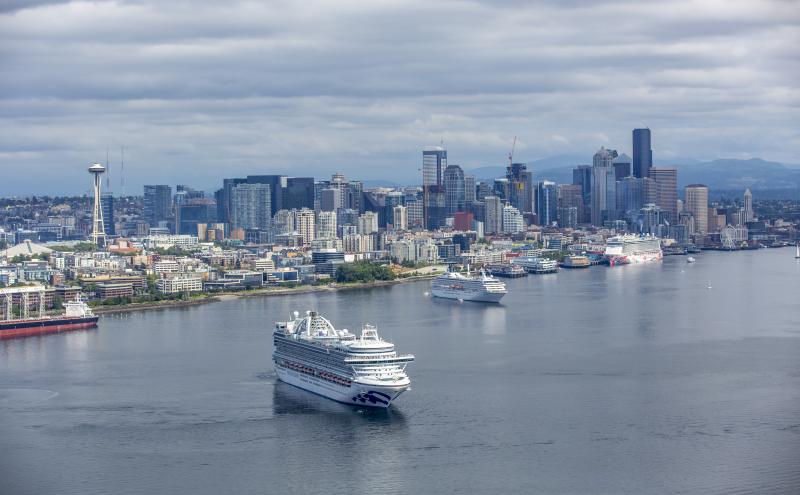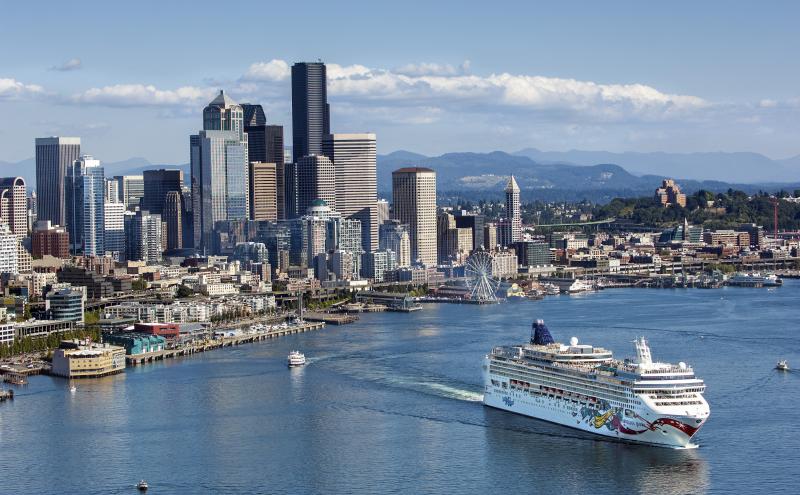
The Port of Seattle, Northwest Seaport Alliance (NWSA) and Seattle City Light (SCL) are embarking on a joint strategy to eliminate emissions from Seattle’s working waterfront. The Seattle Waterfront Clean Energy Strategy (SWCES) is a shared roadmap to electrify the Seattle waterfront, putting in place the clean, reliable energy needed to enable the maritime industry’s transition away from fossil fuels.
Why a Seattle Waterfront Clean Energy Strategy?
The SWCES was created to align the electrical infrastructure improvements, technology investments, and implementation strategies that the Port of Seattle, NWSA, and Seattle City Light will need to pursue to facilitate their shared vision of phasing out maritime industry emissions and reducing pollution exposure and environmental disparities in neighboring communities.
Through commitments in the Northwest Ports Clean Air Strategy, the Ports have a shared vision to phase out maritime industry emissions by 2050. The City of Seattle has similarly established targets to reach net zero emissions city-wide in the same timeframe. The Port of Seattle recently accelerated goals for its own operations, aiming to reach net zero even sooner – by 2040.
Figure 1: Plans Supported by the SWCES

To understand the scale of change, imagine everything it takes to run a zero-emission terminal. Operators will need new investments in cargo handling equipment, fleet vehicles, and new or adapted buildings and facilities. Energy storage technologies and modernization of the electric grid may be needed to accommodate increased demands and operational requirements. Massive amounts and new forms of renewable energy will be required to power everything, including vessels, which may be using electricity, clean hydrogen, or other sustainable maritime fuels and technologies that have yet to be developed at the scale needed for shipping and cruise.
Ensuring that power is available to support this transition will require close, ongoing coordination between the Ports and Seattle City Light, with advance planning and coordination on new technologies and capital projects. The SWCES lays the groundwork for this collaboration by forecasting electricity load growth and associated capacity constraints to 2050, identifying necessary electrical distribution infrastructure upgrades across the Ports and Seattle City Light, and establishing a framework for long-term joint collaboration to implement these findings.
Key Findings
The SWCES forecasted Port electricity demand growth to 2050 and identified future electrical capacity constraints. Of the 24 Port sites initially identified for consideration under the SWCES, a subset of sites were identified for further analysis: 11 priority sites expected to face significant constraints, 4 spot-load sites which were expected to remain stable but where specific electrification loads were expected to be introduced, 3 truck charging sites modeled for a heavy-duty truck charging depot scenario, and 4 near-port sites which were expected to impact utility infrastructure that is shared with the Port.
The analysis found that Port peak electricity demands will increase four-fold by 2050 as compared to a 2019 baseline, driven in the near-term by the use of shore power for ocean-going vessels, and in the longer term by the charging of electric vehicles, vessels and terminal equipment. Major nearby users that share utility distribution feeders with Port sites, such as the United States Coast Guard and Washington State Ferries, are also significant contributors to demand growth. Figure 2 below shows peak energy demand growth modeled through the SWCES for four different scenarios: business-as-usual, low, medium, and high. Each scenario utilized different assumptions about rates of electrification, future policy changes, and a variety of other factors that will affect energy demand.
Figure 2: Port of Seattle Forecasted Peak Energy Demand to 2050, All Scenarios

Based on this forecast, the SWCES found that both Seattle City Light and Port electrical infrastructure will face constraints in the future. Of the 16 Seattle City Light distribution system feeders serving key maritime facilities, 10 are expected to exceed their electrical capacity planning limits by 2040. In addition, multiple on-terminal Port substations will face capacity constraints, with eight sites expected to exceed total site capacity through the forecasted timeframe.
To address these constraints, the SWCES identifies approximately $208 to $457 million in needed investments to electrical distribution infrastructure across the Port of Seattle, NWSA, and Seattle City Light, including both on-terminal port infrastructure and supporting utility infrastructure. This estimate only includes electrical distribution (including substations, transformers, electrical feeders, and associated equipment) and does not include the costs of end-use zero-emission technologies, such as zero-emission trucks or cargo-handling equipment, electric vehicle supply equipment (EVSE), zero-emission harbor vessels, or building upgrades.
What’s Next
To facilitate the development and implementation of the SWCES, the Port of Seattle, Northwest Seaport Alliance, and Seattle City Light signed a Partnering Agreement in 2021 that memorialized a shared vision for the strategy, established joint commitments and laid out a 10-year term for ongoing collaboration for implementation.
In accordance with the Partnering Agreement, the parties agreed to develop and implementation framework to guide ongoing implementation of the SWCES. This framework lays out implementation workstreams and a schedule for ongoing planning, coordination, and adjustment. It will allow the parties to plan for timely delivery of capital projects, assess the pace of technology deployment, support deployment of electrified equipment, and make necessary adjustments.
The Ports and Seattle City Light are kicking off implementation in 2025 by assessing the near-term capital projects identified in the SWCES and identifying the necessary steps to develop them into actionable capital projects that can incorporated into the capital improvement plans of the Ports and the utility.
Seattle Waterfront Electrification Projects
- Pier 66 Shore Power Press Release, October 2024
- Port of Seattle Adopts Shore Power Requirement for Cruise Vessels, June 2024
- Terminal 5 Shore Power Press Release, April 2023
- Puget Sound Zero-Emission Truck Collaborative






